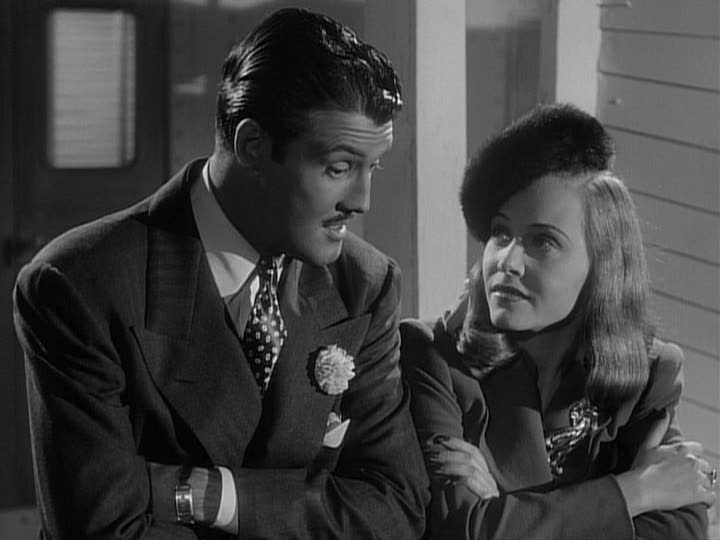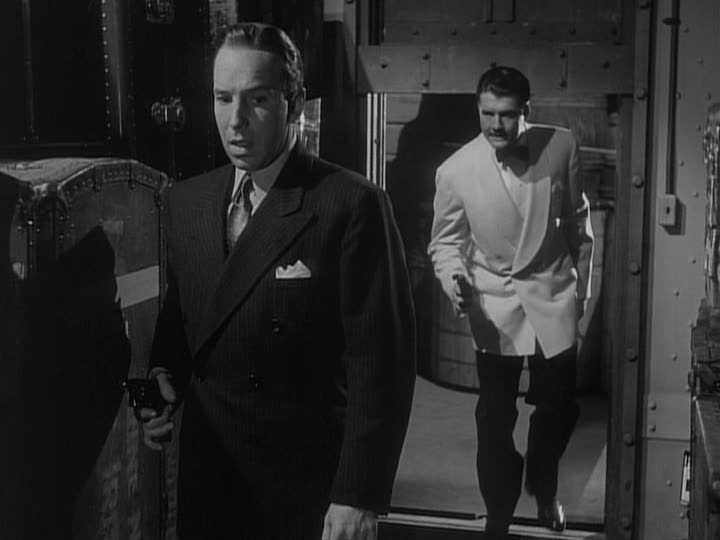
Blue, White and Perfect is the fourth film in the Michael Shayne mystery series, starring Lloyd Nolan as the hapless private detective who's always down on his luck, and who often bumbles through his cases on pure luck and the intervention of others rather than his own sleuthing skills. That's the case here as well, though this film puts the focus more on Shayne himself than the earlier films, with their great casts of character actors, did. Nolan has a lot of fun with this role, playing Shayne as a comic figure rather than an actual good detective: it's only in the film's increasingly less interesting second half that the film really settles into the mystery mold. It's much more fun when the script gives Nolan some comic business to do, like the great series of gags involving a convenience store that Shayne stumbles into, shocking the proprietor and his wife with his odd, plot-motivated behavior. First, he makes a call to his girlfriend Merle (Mary Beth Hughes, who played a different part in the earlier Shayne outing Sleepers West). She thinks he works in an airplane factory, so he accompanies the call with improvised industrial noises using a fan, blender and various metallic banging sounds. Of course, he's really on a case, trying to route out a gang of Nazi diamond smugglers, so when he next returns to the store, he's hiding from the bad guys by trying on a series of scary masks. Finally, he nearly lands on the store owners when leaping through their awning from a second-story window. It's all played for humor, with Nolan's broad mugging matched by the deadpan reaction shots of the store owners, who look on in amazement at all this buffoonery.
Equally fun is the gag where Shayne keeps returning to the office of a printer (Charles Williams) to get new business cards printed out, each time with a new name and a new occupation, and sometimes a horrendous accent to go with it — it's not clear if Shayne's hapless lack of talent as a master of disguise is an intentional part of the joke, or if it's simply a result of Nolan's limits as an actor. Probably, the filmmakers are in on the joke, especially since when Shayne disguises himself as a distinguished Southern gentleman, he tells the printer to "throw a 'Colonel'" in front of his assumed name, and opts for Lee rather than Sherman as an appropriate surname. This is the level of the film's corny humor, and only Nolan's laidback persona and sly wit can bring across the film's low-key pleasures.

Of course, in the film's second half the mystery itself comes to the forefront, though as usual in this series calling it a mystery is something of a misnomer. Because the film doesn't strictly follow Shayne but also spends time with the villains, the audience is ahead of Shayne in knowing what's going on. So there's no mystery, only the question of when (or if) the detective is going to catch on to the plot. The German smuggler Vanderhoefen (Steven Geray) is bringing stolen industrial-strength diamonds to Honolulu on board a steamship. (Never mind why the Germans are shipping things through Hawaii; don't look to these films for any kind of sense.) To help with his scheme, he enlists the lovely, crooked Helen Shaw (Helene Reynolds), who turns out to be an old friend of Shayne's. The onboard shenanigans are complicated by the presence of the absurdly named Juan Arturo O'Hara (George Reeves), a Latin/Irish playboy whose role in this plot is ambiguous, and the courtly steward Nappy (Curt Bois), who seems to be working for everyone and keeping an eye on everything from his inconspicuous vantage point. The action on the ship is largely static and circuitous, moving at a slow pace that defuses any real potential for suspense or intrigue. The mysterious gunshots that ring out periodically, always just missing any potential targets, only add to the pointless confusion.
The only real fun here comes in the interaction of Nolan with his supporting cast, especially the lively Reynolds, who's a far better romantic/comic foil for the leading man than his actual girlfriend, who's mostly reduced to stock throwing-objects-at-the-cad humor. Reynolds gives her character some real femme fatale frisson, casting electrically charged glances at Shayne as she covers her scheming with thick layers of playful banter. Director Herbert I. Leeds, taking over the series from Eugene Forde, who directed the first three films, proves himself just as anonymous and inconsequential as his predecessor. The staging is flat and sometimes awkward, and scenes drag on for too long with no real point. Leeds' one real saving grace is a modest feel for comic timing in some of the earlier scenes. No one would ever call the Michael Shayne movies great cinema, but they're fun enough for a light diversion, and Blue, White and Perfect encapsulates both the series' minor charms and its limitations.








0Awesome Comments!